Best Yoga for Joint Pain and Arthritis Relief 🧑⚖️
March 18, 2025 | by paruli6722@gmail.com
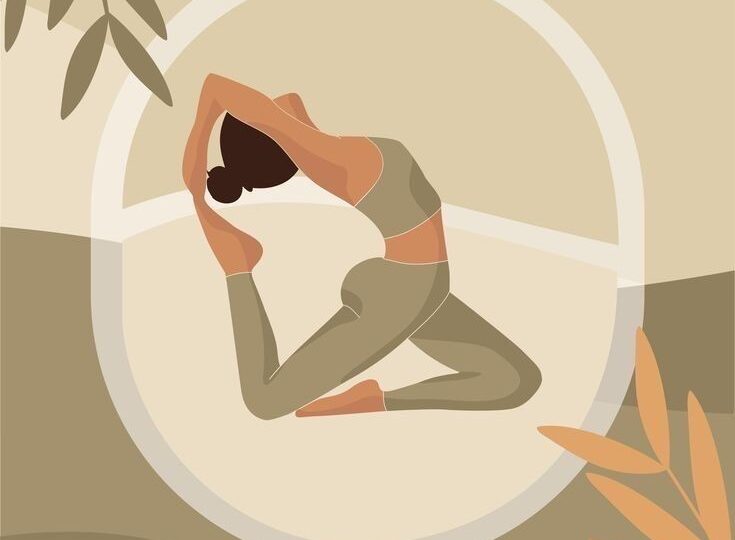
Arthritis and joint pain can make daily activities difficult, but yoga can be an effective natural remedy. Regular practice of yoga helps in reducing stiffness, improving flexibility, and strengthening muscles around the joints. Let’s explore how yoga can help manage joint pain and arthritis effectively.
🧮 What is Arthritis and Joint Pain?
Arthritis is a condition that causes inflammation and stiffness in the joints. It can affect any joint in the body and lead to pain, swelling, and reduced mobility. Some common types of arthritis include:
- Osteoarthritis (OA) – Wear and tear of joints.
- Rheumatoid Arthritis (RA) – An autoimmune disorder causing joint inflammation.
- Gout – A form of arthritis due to excess uric acid.
Yoga helps by reducing inflammation, improving circulation, and strengthening muscles around the joints, which can relieve pain and increase mobility.
🏆 Benefits of Yoga for Joint Pain and Arthritis
- Reduces stiffness and increases flexibility.
- Strengthens muscles around the joints for better support.
- Enhances blood circulation, reducing inflammation.
- Improves balance and posture, preventing further joint damage.
- Reduces stress and anxiety, promoting overall well-being. https://fitnessformanavta.com/yoga-for-heart-health-nurturing-your-cardiovascular-wellness/
🏋️♂️ Best Yoga Poses for Joint Pain and Arthritis
Here are some simple and effective yoga poses that can help manage joint pain:
1. Tadasana (Mountain Pose)– The Foundation of Strength and Stability 💪
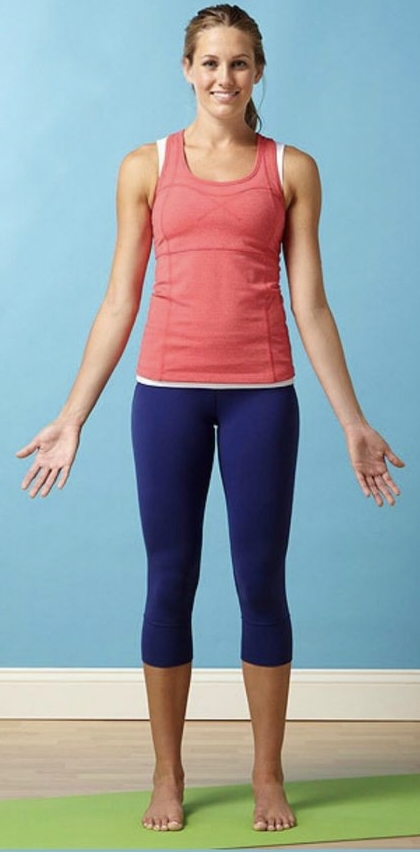
Tadasana, or Mountain Pose, is a simple yet powerful yoga posture that improves body alignment, strengthens the leg joints, and enhances overall stability. This foundational pose is especially beneficial for individuals suffering from arthritis and joint pain as it promotes better posture and reduces strain on the joints.
How to Do:
- Stand upright with your feet together and arms by your sides.
- Distribute your weight evenly across both feet.
- Inhale deeply and stretch your arms overhead, fingers pointing upwards.
- Lift your heels slightly and balance on your toes.
- Hold this position for 10-15 seconds while breathing deeply.
- Exhale and slowly lower your arms and heels back to the ground.
Benefits:
- Improves posture and aligns the spine.
- Strengthens knees, ankles, and thigh muscles.
- Enhances balance and body awareness.
- Reduces stiffness in the legs and lower back.
- Helps in reducing stress and increasing concentration.
Precautions:
- Avoid this pose if you have severe dizziness or balance issues.
- If standing on toes is difficult, keep feet flat on the ground.
- Perform near a wall or use a chair for support if needed.
2. Vrikshasana (Tree Pose)– Enhancing Balance and Stability 🌳
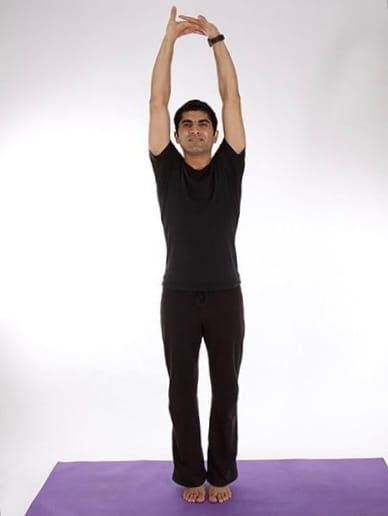
Vrikshasana, or Tree Pose, is an excellent yoga posture that enhances leg strength, joint stability, and body balance. This pose is particularly beneficial for those suffering from arthritis, as it helps improve coordination and strengthens the lower body.
How to Do:
- Stand straight with your feet hip-width apart.
- Shift your weight onto your left foot and lift your right foot.
- Place the sole of your right foot against your left thigh (above or below the knee, but not on the knee).
- Join your palms in a prayer position at your chest or raise them overhead.
- Focus on a point ahead and maintain balance for 10-20 seconds.
- Exhale and gently lower your foot back to the ground.
- Repeat on the other side.
Benefits:
- Strengthens ankles, knees, and hip joints.
- Improves posture and body alignment.
- Enhances concentration and mental stability.
- Helps in relieving stiffness in the lower body.
Precautions:
- Avoid this pose if you have severe knee or hip pain.
- If balancing is difficult, keep your foot lower on the leg or use a wall for support.
- Do not place the foot directly on the knee joint to prevent strain.
3.Sukhasana (Easy Pose) 🧘♂️ – Relaxation and Joint Comfort
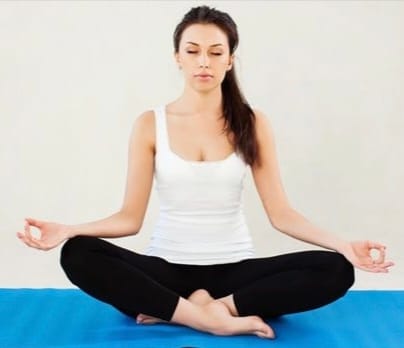
Sukhasana, or Easy Pose, is a simple seated posture that promotes joint flexibility, relaxation, and stress relief. This pose is ideal for those with arthritis, as it gently opens up the hips and knees without putting pressure on them.
How to Do:
- Sit on a yoga mat with your legs crossed and your spine straight.
- Rest your hands on your knees with palms facing up.
- Close your eyes and take deep breaths.
- Relax your shoulders and keep your back upright.
- Hold this position for 1-2 minutes, focusing on your breath.
- Slowly release and stretch your legs.
Benefits:
- Reduces stiffness in the knees and hips.
- Improves flexibility in the lower body.
- Enhances posture and relieves back tension.
- Promotes relaxation and reduces stress levels.
Precautions:
- If you have severe knee pain, sit on a cushion to support your hips.
- Avoid this pose if you have recent hip or knee injuries.
- Do not force your knees to touch the ground; allow natural flexibility.
4.Bhujangasana (Cobra Pose) 🐍 – Relief for Joint Pain and Arthritis
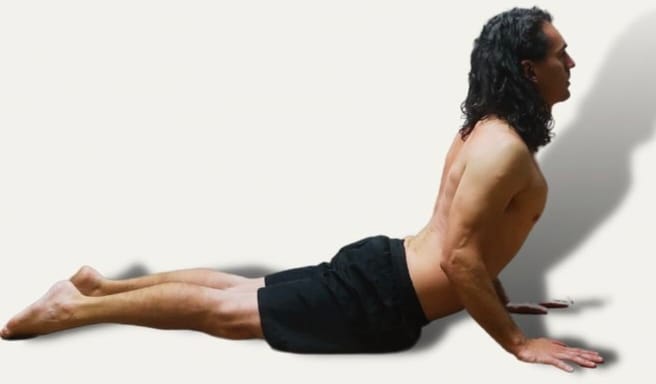
Bhujangasana, also known as Cobra Pose, is a powerful yoga posture that helps strengthen the spine, improve flexibility, and relieve stiffness in joints. This gentle backbend stretches the muscles and reduces inflammation, making it beneficial for people suffering from arthritis and joint pain.
🔹 How Bhujangasana Helps in Joint Pain and Arthritis?
✅ Strengthens the Spine – Improves posture and reduces pressure on the back joints.
✅ Reduces Stiffness – Enhances flexibility in the shoulders, back, and wrists.
✅ Stimulates Blood Circulation – Promotes healing and reduces inflammation.
✅ Opens the Chest & Lungs – Enhances oxygen flow, which helps relieve tension in the body.
✅ Relieves Lower Back Pain – Beneficial for people with mild back pain caused by arthritis.
🧘♂️ How to Perform Bhujangasana (Cobra Pose)?
1️⃣ Lie flat on your stomach with your legs extended and hands placed under your shoulders.
2️⃣ Press your palms into the mat and slowly lift your upper body while inhaling deeply.
3️⃣ Keep your elbows slightly bent and shoulders relaxed.
4️⃣ Stretch your spine while keeping your lower body firmly on the floor.
5️⃣ Hold the pose for 15-30 seconds, breathing deeply.
6️⃣ Exhale and slowly lower your body back to the mat.
7️⃣ Repeat 2-3 times as per your comfort.
⚠ Precautions While Practicing Bhujangasana
🚫 Avoid if you have severe back pain or spinal injuries.
🚫 Do not overarch your back, as it may cause strain.
🚫 If you have wrist pain, place a soft towel under your hands for support.
🚫 People with hernia or pregnancy should avoid this pose.
🔹 Additional Tips for Maximum Benefit
✔ Practice Bhujangasana in the morning on an empty stomach for better flexibility.
✔ Combine with gentle stretching exercises to improve mobility.
✔ Use a yoga mat or soft surface to avoid unnecessary strain on the joints.
✔ Maintain a slow and steady breath while holding the pose.
Bhujangasana is an excellent natural therapy for joint pain and arthritis relief. It not only improves flexibility but also boosts overall strength and well-being. Start practicing today and feel the difference! 🙏
5. Setu Bandhasana (Bridge Pose) 🛢️ – Strengthen Your Joints and Relieve Pain

Setu Bandhasana (Bridge Pose) is a highly beneficial yoga posture for individuals suffering from joint pain and arthritis. This pose helps in strengthening the back, hips, and knees while improving circulation and reducing inflammation in the joints. It also provides a deep stretch to the spine and relieves tension in the lower body.
🧘♂️ How to Perform Setu Bandhasana (Bridge Pose) Properly
1️⃣ Starting Position:
- Lie down on your back on a yoga mat.
- Keep your feet flat on the floor, hip-width apart, and bend your knees.
- Place your arms beside your body with palms facing down.
2️⃣ Lifting the Hips:
- Inhale deeply and press your feet into the ground.
- Slowly lift your hips off the floor, engaging your lower back and thighs.
- Keep your shoulders and arms firmly pressed against the ground.
3️⃣ Holding the Pose:
- Keep your knees aligned with your feet and avoid spreading them apart.
- Clasp your hands under your back for extra support (optional).
- Hold the position for 15-30 seconds, breathing deeply.
4️⃣ Releasing the Pose:
- Exhale slowly and gently bring your hips back to the ground.
- Relax for a few seconds before repeating the pose.
💪 Benefits of Setu Bandhasana (Bridge Pose)
✅ Strengthens the back, thighs, and knees – Helps in reducing joint stiffness.
✅ Improves blood circulation – Enhances oxygen supply to the joints, reducing pain.
✅ Relieves tension in the lower back and spine – Beneficial for people with arthritis.
✅ Enhances flexibility – Increases mobility in the hip and knee joints.
✅ Calms the mind – Helps in reducing stress, which can indirectly relieve joint pain.
⚠️ Precautions While Practicing Setu Bandhasana
❌ Avoid if you have severe knee pain, back injury, or spinal issues.
❌ Do not over-arch the back; keep the movement controlled.
❌ If you have neck pain, place a folded towel under your shoulders for support.
❌ Pregnant women should practice this pose under expert supervision.
✨ Pro Tip: If you find it difficult to lift your hips, place a yoga block under your lower back for support.
Setu Bandhasana is a fantastic pose to strengthen your joints and relieve pain naturally. Add this pose to your daily yoga routine for improved flexibility and joint health! 🙏💙
Home Remedies for Joint Pain and Arthritis Relief 🏡🌿
Joint pain and arthritis can make daily activities difficult, but some simple home remedies can help reduce pain and improve mobility naturally. Here are some effective natural remedies to relieve joint pain and inflammation.
1️⃣ Turmeric Milk 🥛🌿
Why it Works: Turmeric contains curcumin, a natural anti-inflammatory compound that helps reduce joint pain and stiffness.
How to Use:
- Add 1 teaspoon of turmeric powder to a glass of warm milk.
- Mix well and drink it before bedtime.
- You can add honey for better taste and benefits.
2️⃣ Ginger Tea 🍵🌱
Why it Works: Ginger has anti-inflammatory and pain-relieving properties that help reduce swelling and stiffness in joints.
How to Use:
- Boil 1 cup of water and add 1 teaspoon of grated ginger.
- Let it simmer for 5-10 minutes, then strain and drink.
- Drink twice a day for better results.
3️⃣ Mustard Oil Massage 💆♂️🌿
Why it Works: Massaging with mustard oil improves blood circulation, reduces stiffness, and relieves joint pain.
How to Use:
- Warm 2 tablespoons of mustard oil and gently massage the painful joints for 10-15 minutes.
- Do this twice a day for relief.
4️⃣ Epsom Salt Soak 🛁🧂
Why it Works: Epsom salt is rich in magnesium, which helps relax muscles and reduce inflammation.
How to Use:
- Add 1-2 cups of Epsom salt to warm bathwater.
- Soak for 15-20 minutes to relieve joint stiffness.
- Repeat 3 times a week for the best results.
5️⃣ Fenugreek Seeds (Methi) 🌿
Why it Works: Fenugreek seeds have anti-inflammatory and antioxidant properties that help reduce arthritis pain.
How to Use:
- Soak 1 teaspoon of fenugreek seeds in water overnight.
- Eat the soaked seeds in the morning on an empty stomach.
- You can also drink fenugreek tea for relief.
6️⃣ Hot and Cold Therapy ❄🔥
Why it Works: Heat relaxes muscles and improves blood flow, while cold therapy reduces swelling and numbness.
How to Use:
- Apply a hot pack to stiff joints for 10-15 minutes.
- Use a cold pack wrapped in a towel for 10 minutes to reduce swelling.
- Repeat as needed.
7️⃣ Garlic Remedy 🧄
Why it Works: Garlic has anti-inflammatory properties that help reduce joint pain and swelling.
How to Use:
- Eat 2 raw garlic cloves daily in the morning.
- You can also mix crushed garlic with warm mustard oil and massage the affected area.
8️⃣ Apple Cider Vinegar (ACV) 🍏
Why it Works: ACV helps remove toxins from joints and improves mobility.
How to Use:
- Mix 1 tablespoon of apple cider vinegar with warm water and drink daily.
- You can also soak a cloth in ACV and apply it to painful joints.
9️⃣ Omega-3 Fatty Acids (Flaxseeds & Fish Oil) 🐟🌿
Why it Works: Omega-3 fatty acids reduce joint inflammation and stiffness.
How to Use:
- Eat flaxseeds, walnuts, and chia seeds daily.
- Take fish oil supplements after consulting a doctor.
🔟 Stay Active with Gentle Exercises 🏃♂️🧘♀️
Why it Works: Regular movement prevents stiffness and keeps joints flexible.
What to Do:
- Try yoga, walking, or swimming for 20-30 minutes daily.
- Avoid high-impact exercises that stress joints.
💡 Final Tips for Joint Pain Relief
✔ Maintain a healthy weight to reduce joint pressure.
✔ Drink plenty of water to keep joints lubricated.
✔ Eat more fruits and vegetables rich in vitamins and minerals.
✔ Avoid processed foods and excessive sugar, which worsen inflammation.
These simple home remedies can help manage joint pain and arthritis naturally. For severe pain, consult a doctor or yoga expert for proper guidance.
🧐 Tips for Practicing Yoga with Joint Pain
- Start with gentle stretches before performing yoga poses.
- Avoid high-impact movements that strain the joints.
- Use props like cushions, yoga blocks, or a chair for support.
- Maintain slow, steady breathing during the practice.
- Practice under expert supervision if you have severe arthritis.
🤌 Precautions While Practicing Yoga for Joint Pain
- Avoid poses that strain the joints excessively.
- Practice slow movements and don’t force stretches.
- Use props like cushions or yoga blocks for support.
- Consult a doctor if you have severe pain or injuries.
🏡 Lifestyle Changes for Better Joint Health
- Maintain a healthy diet rich in omega-3 fatty acids and calcium.
- Stay hydrated to keep joints lubricated.
- Maintain a healthy weight to reduce pressure on joints.
- Get adequate rest to allow joints to recover.
- Engage in low-impact activities like swimming or walking.
Most Frequently Asked Questions About Joint Pain and Arthritis (With Answers) 🤔💡
Here are some of the most commonly asked questions on Google regarding joint pain and arthritis, along with their answers.
1️⃣ What is the main cause of joint pain?
Answer: Joint pain can be caused by arthritis, injury, inflammation, or age-related wear and tear. The most common types include osteoarthritis, rheumatoid arthritis, and gout. Lack of physical activity, poor diet, and obesity can also contribute to joint pain.
2️⃣ How can I relieve joint pain naturally?
Answer: Natural ways to relieve joint pain include:
✔ Practicing gentle yoga and stretching 🧘♂️
✔ Using turmeric and ginger for their anti-inflammatory properties 🌿
✔ Massaging with mustard or coconut oil 💆♂️
✔ Applying hot and cold therapy ❄🔥
✔ Maintaining a healthy diet and exercise routine
3️⃣ Can arthritis be completely cured?
Answer: There is no permanent cure for arthritis, but its symptoms can be managed effectively through yoga, diet, medication, and lifestyle changes. Early diagnosis and proper care can help prevent further joint damage.
4️⃣ What foods should I avoid for joint pain?
Answer: Avoid inflammatory foods like:
🚫 Processed foods (chips, fast food)
🚫 Sugary drinks and sweets
🚫 Red meat and fried foods
🚫 Excess dairy and gluten (for some people)
Instead, eat fruits, vegetables, nuts, seeds, and omega-3-rich foods for joint health.
5️⃣ Which yoga poses are best for joint pain?
Answer: Some of the best yoga poses for joint pain relief include:
🧘♂️ Tadasana (Mountain Pose) – Improves posture and strengthens joints
🌳 Vrikshasana (Tree Pose) – Enhances balance and stability
🐍 Bhujangasana (Cobra Pose) – Reduces back and joint stiffness
🛢️ Setu Bandhasana (Bridge Pose) – Strengthens the back and knees
6️⃣ What is the best home remedy for arthritis pain?
Answer: Turmeric milk, ginger tea, Epsom salt baths, and mustard oil massage are some of the best home remedies for arthritis pain relief. Regular exercise and a healthy diet can also reduce joint inflammation.
7️⃣ Can drinking water help joint pain?
Answer: Yes! Drinking enough water helps keep joints lubricated, reduces inflammation, and flushes out toxins. Aim for 8-10 glasses of water per day for healthy joints.
8️⃣ Is walking good for joint pain?
Answer: Yes, low-impact walking helps keep joints flexible, improves circulation, and strengthens muscles around the joints. However, avoid overexertion and wear comfortable shoes for support.
9️⃣ Can stress cause joint pain?
Answer: Yes, stress and anxiety can increase inflammation and worsen joint pain. Practicing meditation, deep breathing, and yoga can help manage stress and reduce joint discomfort.
🔟 When should I see a doctor for joint pain?
Answer: You should see a doctor if:
⚠ Pain lasts for more than 2 weeks
⚠ Joints are swollen, red, or warm
⚠ You have difficulty moving the joint
⚠ Home remedies and exercises don’t help
🏡 Conclusion
Yoga is a gentle and effective way to manage arthritis and joint pain. Regular practice can improve flexibility, strengthen joints, and reduce inflammation. Start with simple poses and gradually increase difficulty under proper guidance. With consistency, you can experience long-term relief and better joint health!
Ready to relieve joint pain naturally? Start your yoga journey today! 🙏
RELATED POSTS
View all


